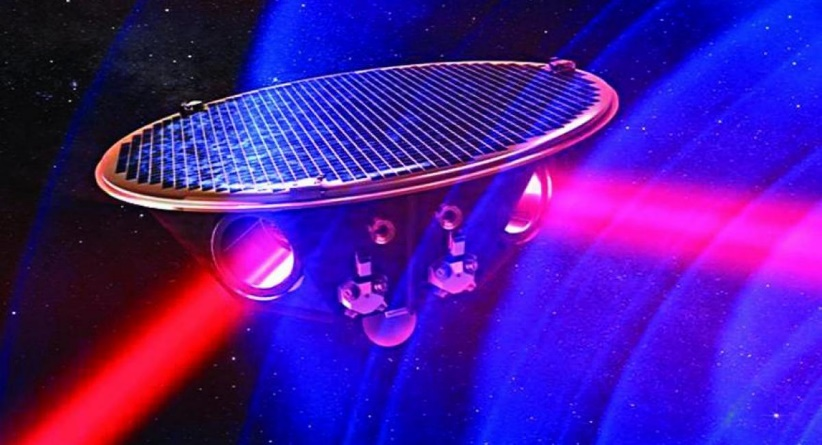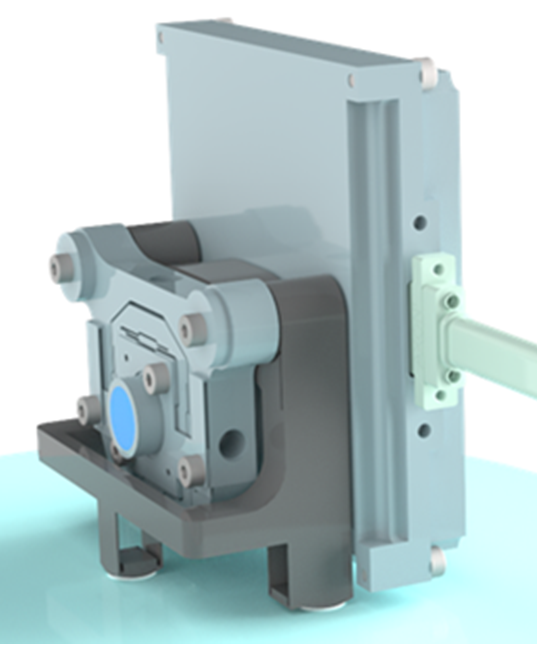Technology

Credit: NASA / C. Henze
Interferometry
Electrical power is scarce in space. LISA’s lasers are therefore only 1 Watt in power. After the 2.5 million kilometres journey, a mere 250 picoWatt remains – a decrease by a factor of four billion. This makes it impossible to employ a conventional Michelson interferometer. The signal would have to be reflected and the laser power would decrease by a further factor of four billion. This would imply that only one photon in every three days would make it back to a detector. To avoid this detrimental feature of large conventional Michelson interferometers in space, LISA employs so-called phase-locked interferometry. When spacecraft B receives a laser beam from spacecraft A, it send a full-power laser beam back with exactly the same phase information as the received signal from the original beam. Spacecraft A then measures the phase of the reinvigorated signal after receival and compares it with the phase of the originally emitted laser beam some 16 seconds prior. If the phase changes between subsequent pulses, a gravitational wave must have passed.
Shielding
External forces, such as from solar wind or cosmic radiation, push the LISA spacecraft back and forth in an unpredictable manner. This will disturb the measurements of gravitational waves. Therefore, each LISA spacecraft houses a free-floating ‘test mass’, shielded from any external forces, only subject to gravitational forces. The test mass is a 46 mm large cube made from a non-magnetic Platinum/Gold alloy. It serves as a reference point for the satellite to keep its position and orientation with an accuracy of ten nanometer—about one ten thousandth of a human hair.
Micro rockets
The spacecraft system senses where exactly its test mass resides through changes in electrical conductivity, in the same manner by which a cell phone senses the position of a finger. If the satellite leans too much to one side, micro thrusters will correct its position with a force of up to a few tens of a micronewton. For comparison: it takes forty thousand micronewton to lift up an ant on Earth. These micro thrusters do not need fuel; they expel cold nitrogen. The accuracy of the applied force must be higher than 0.1 microNewton. Ordinary rocket engines would be too inaccurate.

Credit: ESA/ATG medialab
LISA Pathfinder
To confirm that the concept of interferometry with free floating test masses works, ESA launched the LISA Pathfinder in 2015. This single spacecraft hosted two test masses at a distance of 40 cm to test LISA technology. Won’t there be too much noise from the continuously moving test masses? Will the noise of LISA’s detectors be low enough to pick up the laser light after its millions of kilometres long journey? After two years of testing through LISA Pathfinder, the concept of LISA technology appears to be more than ready to meet the mission’s requirements.
Dutch contributions

Credit: SRON
Quadrant photo receivers
The quadrant photo receivers (QPRs), detect the infrared laser beams between the three LISA spacecraft on which the passing gravitational waves are imprinted. One could say that they are the eyes of LISA. The laser beams are emitted with a power of a few Watts, but over their course of 2.5 million kilometres, they diverge substantially and by the time they arrive at the opposite spacecraft, a mere few hundred picoWatt is all that remains within the reach of the receiving LISA telescope. When mixed with the local laser, the relative amplitude of the interference signal is less than 1%. Furthermore, the interference is heterodyne, meaning that it changes with a frequency in the order of a few MHz. One of the challenges in developing the QPRs is to beat down the noise to a sufficiently low level that this weak and rapidly changing interference signal can be measured with enough accuracy.
24 QPRs are needed in each LISA spacecraft, not only to measure the distance to the other two spacecraft with an accuracy of 1 picometer, but also to measure other distances within the spacecraft to correct the long-distance measurement and attain that picometer accuracy. Also, every QPR is double redundant to have a backup in the unlikely event that a QPR is lost. This is a common practice in space instrumentation, which cannot be repaired after launch. Each QPR consists of a millimetre-large quadrant photo diode, nearby readout electronics and a firm housing for the former two to keep the photodiode aligned with the interfering laser beams at sub-micron accuracy. The development of the photodiode is carried out by NWO institutes Nikhef and SRON, and the Dutch company BRIGHT Photonics. SRON and Nikhef have been granted funding in 2019 from the National Science Agenda, in 2021 from an NWO-M investment and in 2023 part of a Roadmap grant from NWO. The housing, including a stage that allows finetuning of the position of the photodiode with sub-micrometre accuracy, is being designed by SRON and Nikhef. The sensitive readout electronics, crucial for the required low noise level, is being designed in Belgium, with support from the Albert Einstein Institute in Hannover (Germany). In 2023 a first milestone was reached with the successful production of a prototype that met the requirements. In 2023-2025 a new version will be developed that will be used in the Engineering Model of the Inteferometric Detection System (IDS) of LISA. It includes the design and production of 12 QPRs to completely populatie one optical bench of IDS. In the end 72 QPRs will need to be produced and tested.
Point-ahead angle mechanisme
TNO is developing the point-ahead angle mechanism (PAAM). This mechanism adjusts the pointing of the laser beam on each optical bench to where the receiving spacecraft will be 8 seconds later, when the laser beam will have traversed the 2.5 million kilometres distance. This inter-spacecraft distance varies slightly within a ten thousand kilometres margin. Also, the angle between two spacecraft, as seen from the third spacecraft, varies continuously. Therefore, the laser beam pointing often needs to be adjusted slightly but accurately. The PAAM is designed to be able to adjust the pointing with an accuracy of milliarcseconds, equivalent to a dime on the Eiffel tower as seen from The Netherlands. TNO is developing the PAAM since more than 10 years and has already built several prototypes.


Credit: SRON
Mechanisms Control Unit
A central element in LISA is the optical bench, of which there are six – two on each spacecraft. This disk-shaped bench, 30 cm in diameter and made out of Zerodur glass, carries tens of optical components to steer and measure the laser beams including the QPRs. Some of those components, called ‘mechanisms’, will be adjustable, either to repoint the laser beam, change the beam width or switch between different optical fibres. Electronics are needed to read out positions of the mechanisms and change them. These are called ‘control electronics’. For each of the three mechanisms, dedicated control electronics will be developed on separate boards. These will all be brought together in the so-called mechanisms control unit (MCU). The three mechanisms are envisaged to be provided by Belgium, Czechia and the Netherlands. One mechanism is the point-ahead angle mechanism (PAAM) being developed by TNO in the Netherlands, as described above. The control electronics for the PAAM are in development by SRON. SRON will also assume responsibility for the MCU. This entails the definition of the requirements for the three control electronics boards so that they fit in the MCU and the interface to the rest of the LISA system, integration of all boards in one housing, and development of an electronics board for input/output of signals to the rest of the LISA system and the distribution of electrical voltages to the various boards.
Software
The LISA-NL consortium intends to also contribute to the software that is needed to translate the telemetered data to science data. This translation is more complicated in gravitational wave detectors compared to conventional telescopes. LISA ‘sees’ the entire gravitational wave sky the whole time, in contrast to conventional telescopes that have small fields of view. Disentangling the sources across the sky at different wavelengths is a major software challenge. Furthermore, LISA will not have an internal calibration source and instead needs to resort to cosmic calibration sources at well-known positions and with well-known wavelengths, that often need to be identified on the fly in the data. Finally, much diagnostic power is expected from a multi-messenger approach: combining gravitational wave data with simultaneous optical data obtained with conventional telescopes. Organizing the simultaneous optical observations involves dedicated software. LISA-NL will be ready to contribute to the software for all these applications.
Specific areas where LISA-NL wants to contribute is the connection between pre-flight calibration on the ground and in-flight calibration, defining the requirements for the simultaneous optical observations for meaningful added diagnostic power of the gravitational wave data and developing machine-learning code with hierarchical identification for disentangling the individual sources from the telemetered data.
Finally, LISA-NL aims to develop a new noise model for the quadrant photo diodes and point-ahead angle mechanism, with a focus on the coupling between them, in order to ensure that they will not contribute too much noise to the system as a whole.
